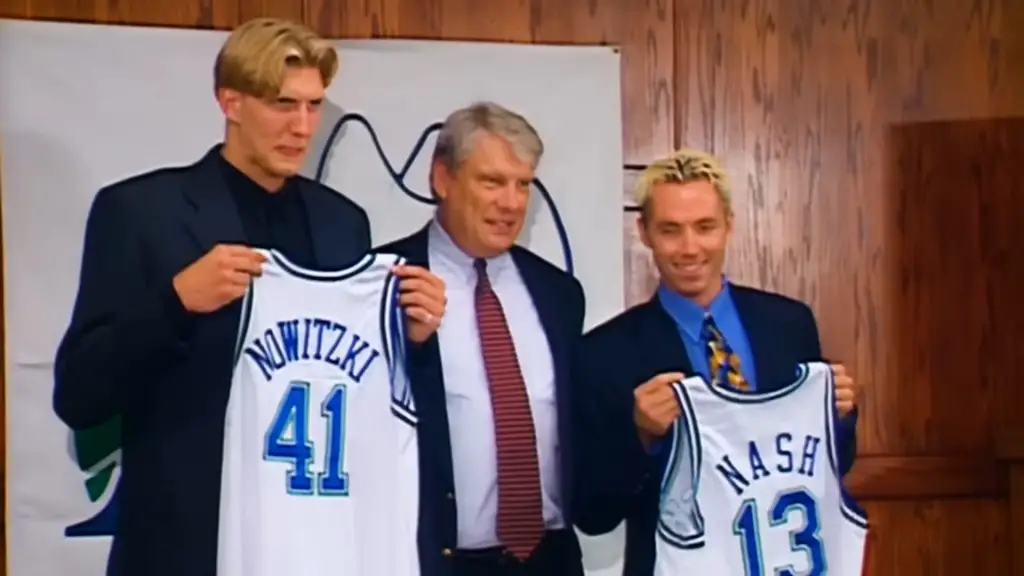Few athletes have changed the fabric of professional basketball like Steve Nash.
A two-time NBA MVP and one of the game’s most creative playmakers, he transformed the way point guards lead teams.
His career was built on intelligence, precision, and a relentless commitment to teamwork.
Known for selflessness, leadership, and visionary passing, he became not just a star but a cultural icon whose influence extends far beyond the court.
His legacy rests not only in assists and shooting percentages but in how he redefined what excellence in basketball could look like.
Let us introduce you to the biography of one of the best NBA players of all time, Steve Nash.
Early Life and Background

A global upbringing shaped Steve Nash long before he became a basketball legend.
His story begins in Johannesburg, South Africa, where he was born in 1974, but his family soon relocated to Victoria, British Columbia, Canada.
Growing up in a sports-oriented household, Nash was encouraged to explore his natural coordination and competitive drive.
His father had played professional soccer in South Africa, while his mother nurtured his academic curiosity and creativity.
Soccer was his first passion and taught him crucial athletic traits that later defined his basketball career.
That environment, combined with the rise of sports-driven innovation in Canada, including its growing igaming sector, reflects how the country continues to blend athletic passion with digital engagement
Movement, spacing, and anticipation became second nature on the soccer field, translating seamlessly to the hardwood.
Nash often credited soccer for his exceptional footwork and passing vision.
A natural athlete with an analytical mind, he began applying soccer’s tactical principles to basketball, refining his sense of timing and teamwork.
During his high school years at St. Michael’s University School in Victoria, Nash began to emerge as an exceptional talent.
He led his team to a provincial championship, displaying poise and leadership uncommon for his age.
Still, college recruiters doubted his size and speed. Major programs across North America passed him by, assuming he lacked the physical tools for high-level basketball.
Only Santa Clara University saw potential in the young guard. Accepting their lone Division I offer, Nash arrived determined to prove himself.
Coaches and teammates admired his leadership and tireless preparation.
Professional Basketball Career
A professional path filled with highs, challenges, and reinvention turned Steve Nash into one of the most respected players in basketball history.
Each stage of his career revealed a different aspect of his competitive spirit and creativity.
NBA Entry and Early Years

Entering the 1996 NBA Draft, Nash was selected 15th overall by the Phoenix Suns, a team stacked with experienced guards.
Many analysts viewed him as a project rather than a ready-made star.
Limited minutes behind Jason Kidd and Kevin Johnson tested his patience, but also offered invaluable lessons in leadership and preparation.
Nash became a student of the game, constantly studying film to improve court vision and decision-making.
Rather than get discouraged by his bench role, he treated those early years as an apprenticeship. His dedication to conditioning and skill development during off-seasons impressed coaches.
Small flashes of brilliance hinted at his potential to become a top-tier playmaker.
When opportunities arose, his poise under pressure showed signs of the floor general he would soon become.
Key lessons from Nash’s early NBA years included:
- Importance of patience and learning from veteran mentors.
- Value of film study in building game intelligence.
- Role of work ethic in earning respect and trust.
Breakthrough with Dallas Mavericks

A trade to the Dallas Mavericks in 1998 marked the true beginning of Nash’s rise.
Partnered with German forward Dirk Nowitzki, he formed a dynamic duo that energized the franchise and its fan base.
Their chemistry developed naturally through shared commitment to improvement and mutual respect.
Together, they transformed Dallas into one of the NBA’s most potent offensive teams.
Nash’s mastery of tempo control and his ability to manipulate defenses turned him into an elite playmaker.
By the early 2000s, he was among the league leaders in assists and shooting efficiency.
Off the court, his friendship with Nowitzki created a foundation of trust that fueled their on-court synergy.
Notable elements of Nash’s Dallas years included:
- Partnership with Dirk Nowitzki as an offensive powerhouse.
- Emergence as a top-tier facilitator and leader.
- Recognition as one of the most efficient shooters in NBA history.
- Growth in confidence and maturity as a franchise cornerstone.
Peak Years with Phoenix Suns
Returning to Phoenix as a free agent in 2004, Nash found the perfect system for his creative genius.
Coach Mike D’Antoni’s high-tempo offense, known as “Seven Seconds or Less,” encouraged:
- Quick ball movement
- Spacing
- Instinctive decision-making
Nash flourished, leading the team to league-best offensive ratings for several seasons.
His back-to-back MVP awards in 2005 and 2006 cemented his status among the game’s all-time greats.
He became a symbol of efficiency and unselfish leadership, guiding Phoenix to multiple playoff runs.
Achievements that defined his Phoenix peak included:
- Two consecutive NBA MVP awards (2005, 2006).
- Leading one of the most efficient offenses in NBA history.
- Multiple 50-40-90 shooting seasons.
- Global recognition for skill-based excellence and teamwork.
Final Years and Retirement
Nash’s move to the Los Angeles Lakers in 2012 was intended to be a final chapter of success alongside Kobe Bryant.
However, persistent back and leg injuries limited his playing time.
Despite physical setbacks, his professionalism and mentorship continued to impact younger players. His approach to preparation and recovery became a model for longevity in professional sports.
After announcing his retirement in 2015, Nash reflected on a career defined by perseverance and innovation.
In 2018, he received basketball’s highest honor: induction into the Naismith Memorial Basketball Hall of Fame.
Career milestones that summarize Nash’s professional legacy include:
- Over 10,000 career assists.
- Eight NBA All-Star selections.
- Four-time member of the 50-40-90 club.
- Induction into the Hall of Fame in 2018.
Style of Play and On-Court Influence

Basketball enthusiasts often refer to Steve Nash’s approach as artistry in motion. His combination of vision, precision, and balance elevated the point guard role into something cerebral and creative.
Every pass and decision reflected a rare combination of confidence and selflessness that defined his reputation among peers.
Nash’s control over tempo was unmatched.
He dictated the rhythm of every possession, reading defensive rotations before they happened and creating advantages for teammates.
Offense revolved around his ability to penetrate defenses, collapse coverage, and deliver perfect passes to open shooters or cutting players.
He also proved to be one of the greatest shooters in history, maintaining elite percentages across all scoring zones. His commitment to efficiency placed him in the rare 50-40-90 club multiple times.
While other players sought personal glory, Nash focused on the collective flow of the game.
He found satisfaction in helping others shine and believed success was measured in team harmony, not statistics.
Key elements of Nash’s playing style include:
- Exceptional passing vision and anticipation of defensive movements.
- Unparalleled control of offensive tempo and spacing.
- Precision shooting, reflected in multiple 50-40-90 seasons.
- Focus on teamwork, rhythm, and unselfish decision-making.
- Influence on future point guards through creativity and efficiency.
Also Read: Amare Stoudemire Biography
Summary
Steve Nash represents more than a brilliant athlete.
He is a thinker, mentor, and humanitarian who reshaped how people perceive leadership in sports.
His influence transcends basketball through his dedication to self-improvement, creativity, and compassion.
#Steve #Nash #Biography #Life #Career #Lasting #Impact #Basketball #WhoWiki.org

